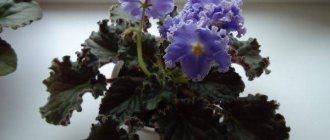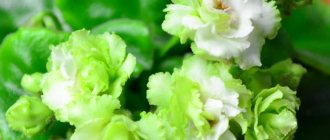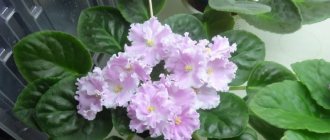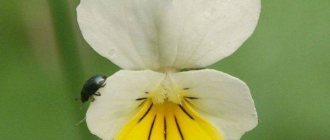An important place in indoor floriculture dedicated to varieties and hybrids of Uzambara violets. Flower growers all over the world love this exotic plant for:
- Charming appearance;
- A huge number of varieties;
- And also - an unpretentious character in terms of content.
To maintain a consistently beautiful decorative effect and create the prerequisites for long, lush flowering, it is enough to :
- Follow simple rules for caring for violets;
- And listen to the advice of experienced Saintpaulia lovers.
If these conditions are met, violets will feel comfortable even in the collections of beginners.
Below in the article you will see a photo and description of the Shanson violet, and also learn everything about caring for it.
Violet Chanson
Beautiful violet Chanson.
Among the original varieties of Saintpaulia, which enjoy constant success among flower growers with various years of experience and experience and often take prizes at various exhibitions, can be called the violet variety “Chanson” with fantasy flowering. Above is a picture of Saintpaulia Chanson.
History of the variety
INTERESTING! Authorship is often attributed to Paul Sorano, a famous plant breeder from the United States, or to employees of his plant breeding enterprise Lyndon Lyon Greenhouses. But on the Sorano website there is no mention of the variety of this magnificent violet.
If the taxonomic position of the Chanson violet variety is determined absolutely precisely and is not subject to any movements in the near future, then it is difficult to reliably name the breeder who grew this variety .
According to some unconfirmed reports, the Chanson violet is the result of domestic selection , however, the specific name of the grower who received this variety is not mentioned anywhere.
Officially, the author of the Saintpaulia variety “Chanson” is considered unknown , and violet catalogs indicate that the breeder is unknown.
Taxonomy
Violet Chanson is a fantasy variety from the genus Saintpaulia hybrida, representing the Gesnerieceae family:
- Based on the size of the rosette, the variety can be classified as an enlarged standard;
- And the shape of the corolla is of the “Bell” type.
Photo and description of the variety
This variety belongs to the standard species.
The original variety with a fantasy type of color forms a compact, standard-type rosette with a very neat outline . Typically, the size of the bush follows the minimum or average size of the standard (about 20 - 30 cm), but when creating ideal conditions for the plant, the rosette can become as large as possible for its type - up to 40 cm.
Violet leaves have a dark green tone with a slight tint of olive color, which:
- Does not always suit flower growers and collectors;
- And this is the only significant drawback of the variety.
From below, the leaves gradually acquire a reddish tint .
The leaf plates have a rounded configuration with a clear venation relief and sit on dense, elongated petioles. The glossy nature of the upper side of the leaves gives them a solemn, elegant look, and the reverse surface is covered with light, fluffy fibers.
ATTENTION! The leaf blades of the Chanson violet variety can be too fragile due to their juicy structure. This should be taken into account when placing the plant on the windowsill.
The flowering of the Chanson variety is of the cap type . Violet corollas are different:
- Particularly large sizes (more than 6 cm);
- And with an increased degree of terry, the edges of each petal have a slightly wavy configuration.
The velvety structure of the flowers is emphasized by sparkling inclusions .
The color tone of the buds varies from a bluish-lilac tint to a thick violet tone with a purple tint. The fantasy of the variety of peas, splashes and specks of various tones of pink on the entire surface of the flower
Peculiarities
Unlike many varieties and hybrids, violet :
- Blooms quite early;
- And it immediately produces abundant buds.
The duration of each flowering is approximately 3 months .
The peculiarities of the variety include the manifestation of its fantasy type only during the second flowering - the corollas of the first stage may not have a pink backlight. The violet gains full strength and beauty during the third blossoming of the buds.
Saintpaulia blooms for about 3 months.
Saintpaulia Chanson is different:
- Rapid growth;
- Formation of green mass;
- Rapid flowering from an early age;
- And the decorative splendor of a blooming rosette.
Violet is a very light-loving plant - with a small amount of daylight, it begins to pull the leaf blades upward, which disrupts its varietal decorative effect.
Description
Fragrant violet
Violet "Chanson" - Saintpaulia, which was bred by a group of breeders under the leadership of Paul Soran, has an unusual and fancy color, as well as a classic size.
Purple velvety inflorescences have large leaves, the size of which can reach 7 cm. The wavy petals are covered with light peas of different shades of pink. The main feature of young plants is the absence of pink drops on the surface of the petals. Each rosette consists of more than 5 inflorescences. The diameter of one rosette is 21 cm. The period of abundant flowering lasts about three months.
The color of the leaves is dark green with an olive tint, and the shape is rounded. Each leaf is attached to a long stalk. The outer edges of the leaf plate are lowered down.
For rapid growth and abundant flowering, it is necessary to create comfortable conditions.
Care in indoor culture
Specimens of Saintpaulia Chanson can be considered an ideal option for the first acquisitions in the collection of novice flower growers. The plant is particularly unpretentious, so it will develop and bloom well with minimal care.
Conditions of detention
The special attitude of representatives of the variety to the illumination of the room predetermines the choice of place for keeping them in indoor culture .
Chanson violets are very light-loving, but do not tolerate direct sunlight on the buds and leaf blades.
Therefore, the most comfortable place for them will be on the windowsills of the western or eastern side of the house , where a balance is created between the amount and intensity of sunlight.
Here it will be possible to preserve the decorative appearance of the violet bush, so with sufficient lighting it will not pull out the petioles of the leaves, and to avoid sunburn.
Placing violets on the north side will require additional lighting with fluorescent spectrum lamps, and when the plants are located on the south windowsill, shading from the hot rays of the summer sun is required.
Tips for proper watering
The Chanson violet watering regime provides for regular moistening of the soil after a slight drying of its top layer - watering frequency:
- Depends on external factors;
- And it is determined based on visual observation of the plant.
Wick irrigation works well for this variety.
For specimens of this variety, twice a week is usually sufficient .
use different watering methods :
- Top watering under the roots with a teapot or a pharmaceutical pear prevents moisture from getting on the leaves;
- Watering through a pan prevents the substrate from acidifying, but requires regular drainage of excess water;
- Wick watering is ideal for long absences of the grower.
Any watering method should be used in conjunction with the organization of good drainage in the flowerpot.
Fertilizing rules
The small volume of soil in the flowerpot and the frequent flowering of violets require additional nutrition for the plant . Fertilizing can be done every month, it is better to apply them:
- In liquid form;
- Or after spilling the substrate.
It is necessary to regulate the content of various elements in the fertilizer depending on the life cycle of the specimen:
- As violets grow, it is necessary to increase the amount of nitrogen;
- During the flowering phase, reduce nitrogen to a minimum, add a percentage of phosphorus and potassium.
This will maintain health and guarantee lush flowering .
Light level control
The main feature of the Saintpaulia variety Chanson is its strong sensitivity to room lighting . Violet reacts positively to long daylight hours and does not like to be in the shade - it slows down growth and can delay flowering dates.
IMPORTANT! Specimens of the Chanson violet may die when placed on northern window sills without additional lighting in winter.
Violet prefers good lighting.
To form an ideal contour of the rosette, it is recommended to regularly rotate the pot with the plant a few degrees from its previous position relative to the light from the window.
Temperature and humidity
To create comfortable growing conditions, violets require maintaining temperatures within +20 + 24°C . In winter, a slight decrease in thermometer readings is allowed - by 2 - 3 degrees. A slight drop in temperature during flowering can extend the life of flowers.
Maintaining the temperature regime requires constant ventilation, which the violet loves very much.
The main thing is to protect the plant from hypothermia and strong movements of air currents, since drafts threaten the violet with severe troubles.
The humidity of an ordinary apartment is somewhat too low for Saintpaulias . You can increase it using:
- Humidifiers;
- Or by regularly spraying around the plant.
Soil requirements
The health and decorativeness of violets directly depends on the quality and nutritional properties of the substrate . For planting, soil rich in various elements is used, but at the same time light, permeable soil with good aeration. Drainage materials and activated carbon can be mixed into the substrate.
ADVICE! The quality of the soil will be preserved longer with a well-thought-out drainage system in the flowerpot.
Soil for Saintpaulias can be bought at a flower shop.
Pruning and hygiene
To provide all violet leaves with a sufficient amount of light, maintain the decorative contour of the rosette and carry out hygienic cleaning in order to protect against rotting, the plant is periodically pruned .
The procedure is to remove :
- Sick and damaged leaf blades;
- Dried corollas and peduncles;
- As well as extra shoots and healthy leaves that thicken the rosette.
Reproduction methods
To obtain young plants in indoor culture conditions, flower growers use several propagation methods :
- Seeds are a rather complex and lengthy process used to breed new varieties. Not suitable for propagation of hybrid violet Chanson, as it does not retain varietal characteristics;
- Leaf cuttings are the most common method: the leaf is rooted in a substrate or in water and then planted in a flowerpot;
- Stepchildren - a simple method, but it depends on the ability of a particular violet specimen to form layering.
Rules for transplantation and rejuvenation
Specimens of the Chanson variety do not tolerate transplantation very well , so such intervention should be carried out only if absolutely necessary. Before the transplant procedure, the following preparations should be carried out:
- Choosing a new flowerpot - a plastic pot should not exceed a third of the diameter of the rosette in volume;
- Arrangement of drainage in the vessel will protect against root rotting;
- Substrate preparation - it is better to use ready-made from the store to avoid infection with diseases or pests.
It is better to replant violets as needed.
CAREFULLY! When choosing between replanting or transshipment, you should pay attention to the fact that replanting with a change of soil allows you to notice damage to the roots of the plant in time, and transshipment is the safest method for the root system. The use of one method or another depends on the reason for transplanting the violet.
At 4–5 years of growth, violets show the first signs of aging . At this age, you can already resort to the rejuvenation method:
- Cut off the upper part of the bush with healthy and young leaves;
- Clean the stem;
- And they send it for rooting according to standard rules.
Difficulties in growing
All possible difficulties in growing Saintpaulia Chanson are associated with infection of the plant by pathogenic microorganisms or the activity of pests that have fallen on the flower. Most often, the variety suffers from fungal, viral and infectious diseases; however, they usually attack weakened violets. The most common problems include powdery mildew, fusarium, late blight and gray mold, which can appear as a white coating on the surface of the leaves or as irregularly sized spots.
Important! It is strictly not recommended to feed the plant during illness. This will not give it strength, because a weakened flower will not be able to properly absorb nutrients and they will only harm it. The first feeding of Saintpaulia after treatment is carried out no earlier than a month after complete recovery.
At the first symptoms of illness, appropriate measures should be taken immediately:
- replace the upper part of the substrate or completely transplant the plant into a new pot (pathogenic spores are best preserved in the soil);
- remove rotten parts and damaged leaves;
- spray the violet with special fungicidal preparations, the most popular of which are Previkur, Bayleton, Fundazol, Fitosporin-M.
Among insects, the Chanson variety is harmed by aphids, scale insects and fungus gnats, spider mites and nematodes are also dangerous You can rid the plant of them with the help of insecticidal preparations like “Aktellika”, “Alatara” and “Aktara”, using them in accordance with the manufacturer’s recommendations (always indicated on the package). “Fitoverm” is effective against nematodes (when applied to the soil). By paying due attention to the Chanson violet, you will not have to worry about its appearance. A healthy flower always pleases household members with its bright and unusual appearance.
Features of flowering, growth and reproduction
In general, the life cycles of Saintpaulia Chanson occur according to the same laws as other varieties and hybrids of Uzambara violets. Only minor differences can be noted in some areas.
Development in indoor culture
Violet Chanson is suitable for growing:
- As in the collections of experienced flower growers;
- So as a first experience for beginning Saintpaulia lovers.
Variety of violets presented:
- Does not impose special requirements on conditions of detention;
- Can easily adapt to the microclimate of a certain room;
- Grows quite quickly;
- It blooms early and very abundantly.
A wonderful gift for true violet growers.
To maintain the decorative appearance and preserve the health of the Chanson violet, it is enough to carefully and strictly follow all care regimens, listening to the advice of experts in this field.
How long does it take to grow an adult specimen?
When rooting a violet from a leaf cutting, it will take about two months . Next, Saintpaulia Chanson must go through the processes of developing a rosette and increasing the leaf mass.
The variety grows in 2 months.
The variety will have about eight months to do this, after which the plant will be able to form the first buds. This means that the young bush gradually becomes an adult violet - if rooting begins in early spring, by the end of winter you can get the first flowering.
The method of rooting a stepson will allow you to grow a young adult bush in a shorter period of time , since the baby is already formed by the time it separates from the mother plant. It will only take her time to grow.
Features of reproduction
Growing young specimens of Chanson violets follows the same rules as all other varieties of Saintpaulia. The plant can be propagated in three ways. Two of them are constantly used by gardeners - these are:
- Rooting a leaf;
- Or the separation of the stepson from the mother plant.
The methods are easy to implement and do not require much time and effort. It is enough to root a leaf or stepson using a mini greenhouse, and then plant the resulting seedling in a place of permanent growth. The main thing is to be careful.
The third method, propagation by seeds , presents great difficulties when used in indoor culture. The seed method is mainly used by breeders to obtain new varieties.
ATTENTION! The seed method is not suitable for propagating hybrid varieties of Saintpaulia, including Chanson violets - the characteristics of the parent forms are not preserved in the offspring. To preserve varietal properties in this case, the rejuvenation method should be used.
Specifics of flowering
The presented Saintpaulia blooms very early.
Violet Chanson can produce its first flowering very early - in the eighth month of life. In this case, the formation of buds occurs rapidly, and a large number of flower stalks are formed. The duration of this wonderful process is about 3 months.
A varietal feature of flowering is the appearance of pink splashes only during the second and sometimes third flowering. The very first buds open in one color. All characteristics of the variety intensify as the number of flowering increases.
Appearance of peduncles
From the first formation of buds, the Chanson variety produces a large number of peduncles . By their nature they are:
- Sturdy;
- Elastic;
- And thick enough to withstand the significant weight of flowers (up to 6 pieces on each of them).
But the violet peduncles of this variety have an interesting feature - they can change their structure during subsequent flowerings . Peduncles can be either erect or tucked onto leaf blades, while firmly bearing all the formed corollas.
Flowering type
Due to the formation of a large number of peduncles, each bearing up to 6 large, double flowers, a neat and lush cap of purple color with a pink glow on the petals is formed above the leaf rosette of the Chanson violet. According to its characteristics, the variety can be classified as violets with cap flowering.
The variety has cap flowering.
Flowering duration
When creating optimal conditions for the flowering phase, the Chanson variety can retain a flowering cap for up to 3 months . Each flower individually can bloom for about a month under comfortable conditions.
Classification by leaves
Hydrangea paniculata white, red, pink - the best winter-hardy varieties
Few people know that the color of violet inflorescences and leaves is inherited together, since this is influenced by its genetically linked characteristics. Varieties with almost black leaves have a burgundy or purple flower color, and those with light leaves have white flowers.
But sometimes hybrids appear that stand out from the crowd and attract attention. They look extremely impressive
Light Frost and Orchard's Night Light have an almost black rosette and white inflorescences. There are also varieties with white leaves.
Varieties of violets with names can puzzle even the most experienced gardener. In some cases, a description of leaf color can help identify the plant variety.
Collectors rarely pay serious attention to the coloring of the reverse side of the sheet, but breeders never make such an oversight. Only a small number of plants have silver, pink or red undersides
Typically, silver-green is characteristic of plants with white and pink flowers, and the red back is characteristic of purple and burgundy varieties.
Unusual violet leaves
Speaking about colors, it is worth mentioning the variegated color and its variants. The variegated mutation is valued for its decorative properties. In this case, abnormal groups appear among normal cells that lack green pigment. Variegation comes in different types: in the form of spots, stripes or streaks.
In any case, all violets are worthy of attention and detailed description, but within the scope of this article a superficial introduction is sufficient. Each variety has unique characteristics, so any gardener will choose a suitable specimen for himself, and maybe several at once for his collection.
Reviews
Tatyana Vasilievna. “I hasten to share my great joy - I finally saw the true blossoming of my Chanson. The first two blooms were very inconspicuous. Although there were many flower stalks, I was not impressed by the flowers. Instead of a magnificent pink pattern against the background of purple petals, I observed simply dark blue buds, which, both in size and plumpness, did not in any way resemble the varietal Chanson.
And now - the third flowering. I have a huge, wildly double flower opening, which simply glows from the pink splashes. Such beauty! It’s not in vain that I waited!”
Nicole. “I read that the Chanson violet is distinguished by foliage with an olive tint of greenery. This color of the leaves is also clearly visible in all the photos. I was given a flower of this variety for my birthday. All signs match the description:
- And big flowers;
- And terry;
- And the coloring is like that of a fairytale bird.
The leaves grow evenly in a circle, shiny on top, fluffy below. But no olive color. Maybe this is not Chanson?
Florists are attracted by the fabulous color of violets.
Anyuta. “My grandmother bought me my first violet and said that her name was Chanson. I really liked her. I put it on the nightstand next to my crib so that I could be close to it when I sleep. But then my Chanson stopped producing leaves, everything drooped and began to dry out. But I watered it correctly. I called my grandmother and complained. And she scolded me and ordered the Chanson to immediately put on the windowsill. At first I was offended and cried. But then I realized that my violet should live on a window where there is a lot of light. Now it’s blooming, and I’m painting it.”
Story
Even in Ancient Greece, the Greeks considered this flower a symbol of sadness and death - most often they used it to decorate the graves of young girls. But, in our modern society, this flower is considered a symbol of the awakening of nature. And oddly enough, it has its own special history.
According to ancient Greek myth, it can be considered that the daughter of Titan, when she was fleeing from Apollo, asked Zeus for help. He, in turn, turned the girl into a beautiful flower, which over time began to be called a violet. After the magical transformation, Zeus hid the flower deep in the forest.
And no one would have noticed her if the violet had not been stolen by Hades, the king of the government of the dead. But suddenly he got scared and dropped the flowers on the ground. They, in turn, began to actively grow and delight everyone around them with their beauty.
The Greeks consider the violet to be one of their favorite flowers. This symbol of Athens appeared back in the days of Ancient Greece. With the help of violets, artists depicted the images of women.
Disease and pest control
If all care regimens are followed, Saintpaulias rarely get sick or are attacked by pests . Only a plant weakened by maintenance errors can be afraid of various pathogens and parasites.
The most dangerous for violets are :
- Gray rot;
- Fusoriosis;
- Powdery mildew;
- And late blight.
At the first signs of disease, the plant must:
- Send to quarantine;
- Transplant;
- Having eliminated all affected areas;
- And treat with fungicides.
If not properly cared for, violets may become pests.
The main pests of Saintpaulia include:
- Cyclamen and spider mites;
- Scale insects;
- Nematodes;
- Aphid.
Control measures:
- Quarantine;
- Removing damaged parts;
- And treatment with insecticides and acaricides.
Possible diseases
Like any plant, violet can also get sick . For such a plant, the greatest danger is posed by infectious diseases, namely: pathogens - viruses, fungi and bacteria, and pests:
- spider mite;
- scale insect;
- nematodes and aphids.
The best thing is to prevent the violet from starting to hurt. Therefore, the most competent solution is the prevention of all diseases by spraying with special preparations.
" Greenhouse effect”, the amazing “Blue Mist”, as well as varieties of the “Optimara” series.
Violet is a plant of amazing beauty that should be in every home. It is quite easy to maintain and therefore suitable for beginners. If there is a desire to propagate the plant, it will not take much effort and effort. And if you successfully complete this task, even more representatives of such a beautiful flower as the violet will appear in your home.
Other varieties of violets with the word Chanson
Violet EK-Russian Chanson
Bright blue violet EK-Russian Chanson.
Variety by breeder E.V. Korshunova. Introduced to a wide range of flower growers in 2014.
A distinctive feature is variegation . The leaf plates are painted in a dark green color, along the edges there is a lilac border with a flesh-colored tint to a greater or lesser extent. The reverse side has a reddish tint.
The leaf itself is wavy, with rounded notches. The flowers are like those of the Chanson variety: large, double structure, with a delicate pink glow. The difference is in color : Russian Chanson has sapphire-tone rims.
Violet NS-Ukrainian Chanson
Mysterious Saintpaulia NS-Ukrainian Chanson.
Variety of breeding work by S. Novoseltseva .
A distinctive feature is the magnificent beet color with a purple tint of the corollas with extremely small dots of pink glow. Flowers with a high degree of terry, highly layered arrangement. Sheet plates:
- Dark shade of green;
- With a reddish reverse;
- With a smooth and shiny surface.
Violet L-Odessky Chanson
Mysterious violet L-Odessa Chanson.
The variety belongs to the selection of T. Lutskaya .
A distinctive feature is the not very strong terry of the corollas with significant fringe of the petals. Large flowers surprise with a plum shade of purple. Against this background, spots and specks of a yellowish lunar color stand out brightly. The leaf blades are dark green with a reddish tint on the reverse side and have a wavy fringe along the edges.
Appearance
The leaves of this plant are large, they have a dark green, uniform color. They are characterized by a rounded shape with high legs. On the reverse side the leaves are drooping, and on the front side they are often smooth, with a slight shine. They are juicy and weightless, very neatly assembled into a rosette. Their shade looks good with flowers.
The flowers of this variety are double to the touch, have a dark blue color, and they are collected in rosettes in the amount of 5-6 pieces. The edges of the petals are wavy or scalloped. Peas are densely scattered on them, reminiscent of sunbeams in appearance. The petals are velvety and have shiny sparkles. Flowering is often abundant and frequent.
Characteristic differences
Upon landing
One of the important conditions is the presence of good drainage. You need to choose a special pot, since the root system of “Chanson” requires it. The pot should be flat and shallow.
As the plant develops, it needs to be replanted every 2-3 years. You should not choose a pot that is too large, since the violet will then spend all its energy on the development of roots, and not on the development of flowers and leaves.When choosing a pot, you need to remember that the diameter of the pot should not be much larger than the plant (the ideal proportion is 3:1)
The material and color of the pot itself depends on the owner; it is best to pay attention to watering, lighting and fertilizing
Since this plant requires a lot of light, but does not tolerate direct sunlight. Therefore, the plant can be placed on an east or west window. The temperature must be at least 18 degrees. The room must be ventilated as often as possible.
For fairly good growth, the recommended air humidity should be 50-70%. It is not recommended to spray the violet, but if you need to increase the humidity, you can fill a jar with water and place it next to the violet.
When growing
"Chanson", unlike other varieties of violets, does not like replanting, so it is recommended to replant it every 2-3 years, trying to maintain the integrity of the plant itself. If the plant begins to bloom, it is better to wait this period and then start replanting. It is best to replant in winter, because spring and summer are the period of abundant flowering.
Priming
The soil substrate is prepared from peat, leaf soil and sand in a ratio of 3:5:1. All ingredients are thoroughly mixed. You can add charcoal and/or sphagnum moss. Expanded clay or vermiculite can be added to the soil. A prerequisite for growing violets is the presence of drainage.
Pot
The characteristics of the root system of violets determine the choice of pot for the plant.
It is better to choose shallow, flat pots - they are more suitable for a superficial root system.
The size and age of the plant must be taken into account. For mini-varieties and children violets, take the smallest pots - up to 6-8 cm in diameter. As the plant grows, every 2-3 years it is transferred to pots of larger diameter.
When choosing a flower pot, you should always adhere to the 3:1 rule - the diameter of the pot should be three times less than the diameter of the plant.
The material for the flower pot can be any - plastic or ceramic.
Lighting
The “Chanson” violet does not like direct sunlight. Leaves react to excess sunlight by appearing whitish spots and burns on them.
Plants live well on western and eastern windows, but on northern windows they lack light.
In autumn and winter, violets need additional lighting. With a lack of light, flowering is delayed and plant growth stops.
Temperature
In winter, the room temperature should not fall below 18 degrees. Comfortable temperature for Saintpaulias is 22/25 degrees. Violets are afraid of drafts. The room must be ventilated regularly.
Humidity
For growth and flowering, this variety requires a humidity of 50% to 70%.
You cannot spray this plant - it may die. Experienced gardeners advise placing containers of water next to the plant. The second method: pour expanded clay into pallets and always make sure it is wet.
Origin
To begin with, it is worth saying that this word comes from the Georgian language, where it means seniority during the celebration. You can also give it another meaning: in charge of the feast. The image that comes to mind is of a man sitting at a table and inviting guests to make toasts, and of course, drinking with the guests. But the modern presenter is a toastmaster who does not want to live up to this image. Today such people have a different image. Who is a toastmaster these days? This is the person who spends the holidays at a professional level. Moreover, holidays include not only weddings, but also New Year, birthdays, and corporate events. The toastmaster will be able to organize and conduct a full entertainment program with games and competitions.
How to breed a new variety at home?
Breeders do not see any serious difficulties in this. Having certain knowledge and skills is mandatory and only contributes to success:
- Pre-define. What do you want to have? Color of buds, leaves and their shape;
- Select suitable healthy parent plants.
Important! Even experienced specialists cannot guarantee an accurate result. Crossing purple and pink produces blue and purple petals. In practice it looks like this:
In practice it looks like this:
- From a selected pair, pollen from one is transferred to the pistil of the other: At a certain time they are ready for pollination;
- Pollen is ready on the 5-6th day after the bud opens;
- The appearance of liquid on the pistil signals the readiness of another flower;
- This is done using a needle.
- And after 15-20 days they are ready for sowing;
Each bush grown can be grown from these seeds. And within 2-3 flowerings we can talk about a certain variety.
Rooting a leaf
Violet "RS-Duchess": description of the variety with photos, care and cultivation
Next, choose one of two rooting methods: in the ground or in water.
Placing a leaf in water allows you to observe the development of roots, but when planting in the ground it takes some time to adapt.
Rooting in water is done as follows:
- We take water into a disposable cup and dissolve an activated carbon tablet in it;
- We immerse the sheet 1 cm;
- We put it in a warm place, but not in the sun;
- After the roots have formed about 1 cm, we transplant them into the soil.
Violet is rightfully considered one of the most popular indoor plants.
In order for the violet to grow symmetrically, it needs to be turned periodically
When rooting into the ground, we act like this:
- We make small holes in the bottom of a disposable glass to drain moisture;
- Pour in some polystyrene foam for drainage;
- We fall asleep in the ground (recipes above);
- We root the leaf 1 cm;
- Water and keep warm. Possible under film;
- After 1.5 months, new leaves appear.
Violet sprouts with new leaves
When the leaves reach medium size, the violet can be planted in a pot.
Arcturus
Unlike many other red-flowered species, the petals of this Saintpaulia retain their color without fading in the sun.
The leaf color is dark green, the leaf shape is standard. "Arcutrus" is very easily propagated by cuttings.
Recommendation from a florist: a violet variety with the unusual name “Arcuturus” is recommended to all those who are just starting to get acquainted with Saintpaulias and want to have this indoor plant at home. Recommendation at home. Flowers usually need constant and proper care. In the case of Arkutus, all you have to do is not forget about watering.
"Arcturus" is perfect for those who love Saintpaulias, but are not ready to cope with their "whims".
Landing
When choosing a pot for planting a mini-violet, it is worth considering that during its growth it does not need larger containers.
The best option for this plant is a flowerpot whose diameter does not exceed 8 cm. Ignoring this condition will lead to the fact that the miniature Saintpaulia will gradually grow and lose its decorative effect. To plant mini-violets, it is advisable to use not very fertile soil, consisting of peat, soil, vermiculite and partially rotted pine needles, mixed in a ratio of 6: 1: 1: 1. Another component of the composition can be charcoal, added in small quantities.
As a rule, miniature Saintpaulia is replanted to replace depleted soil with new one. This procedure requires several conditions:
- The optimal frequency is once a year;
- the most suitable time is the second half of winter;
- The recommended material for the container used is plastic;
- There should be drainage holes at the bottom of the pot.
As for transplantation, it involves performing the following sequence of actions:
place a layer of sphagnum moss at the bottom of the container and cover it with a thin layer of soil; carefully remove the mini-violet from the old pot (along with the earthen lump); Gently fluff the soil around the roots of the plant; determine the height required to immerse the bare section of the stem into the soil; cut the roots to a length sufficient for the Saintpaulia to be placed comfortably in the new soil, and treat them with crushed charcoal; place the mini-violet in the pot so that the petioles of the lower leaves are on its sides; Cover the plant with soil and compact it thoroughly.
To learn how to properly transplant a mini-violet, see the following video.
Useful video
Find out in the video how the Chanson violet blooms:
Watch the video of what to do if Saintpaulia Chanson “pulls her hands up”:
Interesting facts in the video about the Chanson violet:
Find out in the video how Saintpaulia Chanson grows:
Magnificent violets of the Chanson variety fascinate with their fantasy color, amaze with the size of the flowers and captivate with their unpretentiousness. If all the rules and care regimens are followed, these beauties can be grown in home collections by flower growers with any experience.











